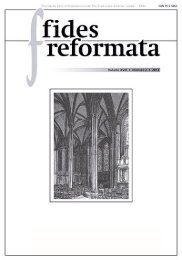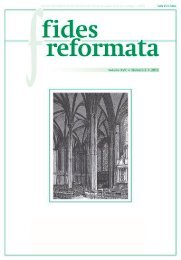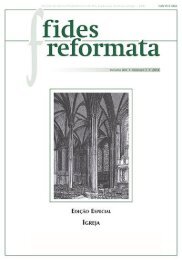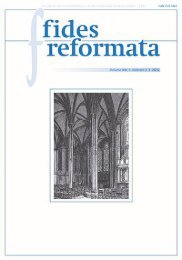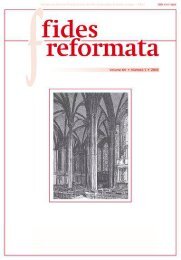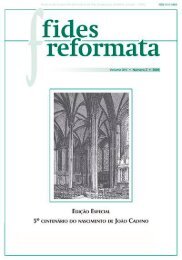Create successful ePaper yourself
Turn your PDF publications into a flip-book with our unique Google optimized e-Paper software.
Breno Mace<strong>do</strong>, Covenant Theology in the Thought of John Calvin<br />
on the basis that “they are destitute of present faith.” Appling the implications<br />
of the nature of the Noahic Covenant, Calvin concludes that God’s promise<br />
to Noah and his thousand generations is legitimate; in this case, however,<br />
parents <strong>do</strong> not function as mediators but as teachers who pass on the words<br />
of the covenant to those after them and incite them to believe those words. 39<br />
Ultimately, again, salvation is by faith.<br />
Similar to the covenant of works that had the tree of life as its sacrament,<br />
the arch over the clouds becomes the sacrament of the Noahic Covenant. By<br />
sacrament Calvin means a “mark [in which] God placed his sign and seal on.” 40<br />
The rainbow, he explains, has always existed, but at the moment that God<br />
impressed upon it his Word, it became a sign of his promise to all those who<br />
believe. Such belief is not the automatic product of the sight of the sacrament,<br />
or the rational association of the phenomenon with its divine meaning. It is<br />
the fruit of the power of the Holy Spirit working in the believer through the<br />
sacrament. 41 Every time the bow shows up in the sky the believer should be<br />
encouraged in his faith in God as the preserver and provider of life. It seems<br />
that here resides for Calvin the redemptive aspect of the Noahic Covenant. It<br />
is not simply a promise of preservation of material life, but of life. He explains<br />
that when the rainbow appears it is always in a circumstance of rain and it<br />
should bring fear and dread to the believer’s heart. But since God’s Word of<br />
promise is now impressed upon it, when it appears, even in a circumstance<br />
of threat, it awakens in the believer the assurance of salvation. The Word engraved<br />
in the sacrament encourages and boosts the Christian’s faith in God’s<br />
provision of salvation. In the New Covenant, this provision is clearly and<br />
totally revealed in the sacrament of the Lord’s Supper, which points to God’s<br />
life in Christ’s death. 42 Thus, the covenant with Noah is not simply a generic<br />
covenant of preservation; it is principally a covenant that promises life, life<br />
eternal, life abundant. The source of this life will be revealed progressively in<br />
the subsequent covenants.<br />
3. Abrahamic Covenant in the thought of<br />
John Calvin<br />
For Calvin, the Abrahamic covenant is the formal establishment of the<br />
covenant of grace. In Abraham, the gathering of a particular people begins to<br />
whom salvation will be granted. Abraham did not conquer or merit this great<br />
39 “…When God promised salvation to a thousand generations, the fathers were not intermediate<br />
parties between God and their children, whose office it is to deliver to their children (so to speak) from<br />
hand to hand, the promise received from God.” Calvin, Commentaries on Genesis, 1:297-298.<br />
40 Calvin, Sermons on Genesis 1 to 11, 760.<br />
41 Calvin, Commentaries on Genesis, 1:298-299.<br />
42 Calvin, Sermons on Genesis 1 to 11, 760-761.<br />
98






